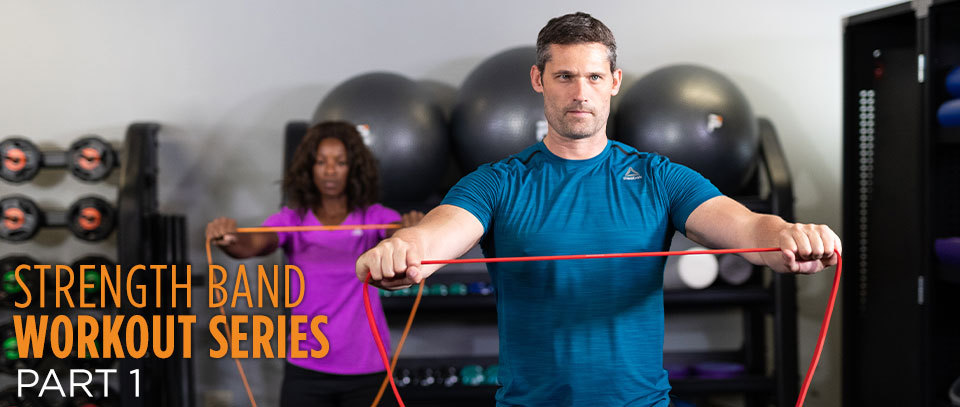Strength Bands are one of the most portable and versatile tools in the gym – however, the simplicity of their design can sometimes stump people on what exactly to do with them. We teamed up with Nick Tumminello, seasoned author and the “trainer of trainers”, to share a few of his favorite, innovative exercises with strength bands. Nick will breakdown a new exercise each week and show you how to implement it into your own workouts or your clients’ training programs.
Strength Band Hybrid Deadlift
Powerlifters often attach bands on each side of the barbell because as the bar rises, the load tension continues to increase (because the band is stretching out) as the lifter continues to gain a mechanical advantage. This is called accommodating resistance.
The Strength Band hybrid deadlift is a unique Strength Band exercise I developed that allows you to get an effective, and easily adjustable accommodating resistance stimulus, no barbell required!
How to Perform the Strength band Hybrid Deadlift
Using a Strength Band to perform the hybrid deadlift involves an easy, but very specific set-up shown in the video.
It’s important to keep in mind to grab the middle of the band with your hands roughly shoulder width apart. Your arms should be close to touching the insides of your legs. You can grab one, two, or three layers of the band depending on your strength level and amount of reps you’re performing.
Once you get the Strength Band situated; keeping your back straight, drive your hips forward toward the band while straightening your legs. Reverse the motion and slowly lower the band back toward to the floor to complete the rep. As you hinge forward to lower yourself down, drive your hips backward and do not allow your back to round. Lift the band by extending your hips, not by overextending your lower back.
Sets, Reps and Tempo
A unique benefit of using the Power Systems Strength Bands over using a barbell to perform the hybrid deadlift is that you can move fast! So, the goal is to perform this exercise in a fairly fast manner while demonstrating spinal control throughout. Of course, the more layers of the band you grab, the slower you’ll move because you’ll be working against a greater resistance.
With this in mind, the Strength Band hybrid deadlift works very well in the higher-rep range. I generally recommend performing then towards the end of a comprehensive strength workout, after heavier, more traditional lifts, for 2-3 sets of 20-30 reps with 2-3 minutes rest between sets.
If you’re looking for more intensity, you can do a triple drop set by performing 8-15 reps holding three layers of the band. Then perform another 15-20 reps holding two layers of the band. The do finish by doing another 15-25 reps holding one layer of the band.
Of course, you can do the above as a drop-set where you begin holding two layers of the band, then drop to holding a single layer of the band if holding three layers is too much for you.
If you’re doing the triple drop-set or drop-set, due to their very high volume nature, I generally recommend performing 1-2 sets with 3-5 minutes rest between sets.
Benefits of the Hybrid Deadlift
This exercise movement gets it’s name because it combines the Romanian and sumo deadlifts, which you’d do with a wider stance and a more upright torso. For many, the hybrid deadlift movement, whether performed with a barbell or with a Strength Band, is a smart substitute for traditional deadlifts for two reasons. First, the wider stance is easier and more natural for most people to do while maintaining the alignment cues. Second, this starting position keeps the resistance (i.e., barbell or strength band) closer to the hip joints than the conventional style deadlift, which provides a shorter lever. This gives you a greater mechanical advantage while placing less overall stress on the lower back.
Nick will be back to breakdown a few more Strength Band exercises in the coming weeks.
This lightweight, portable, and extremely affordable tool can slide into your gym bag or suitcase and provide a Total Body Strength Band Workout anywhere you go. There are 7 different resistance levels available – click here to learn which resistance level is right for your needs.

This post was originally published on May 11, 2018 and updated on May 17, 2019.

You must be logged in to post a comment.